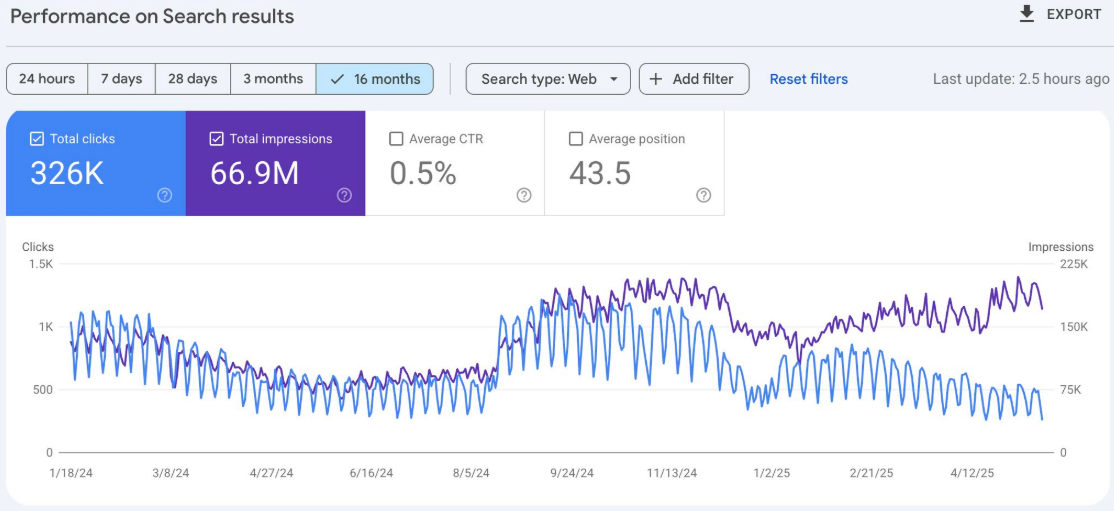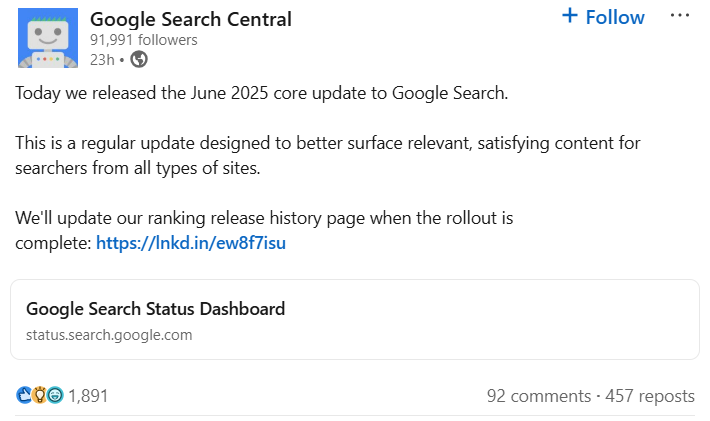The latter half of June brought some significant developments, including a new Google core update, an AI Mode expansion, and a bold move from Cloudflare that could change the way AI search services crawl your content.
Updates are colour coded by importance:
🔴 Major developments likely to impact strategy
🟡Worth watching or understanding
🟢Informative - but lower impact for most
Here’s what you need to know.
Google Search
Google rolling out talk and listen version of Search Live 🔴
In May, Google announced Search Live, a new form of search that allows users to have real-time conversations with Search. These conversations can be centred on visuals (i.e. what your camera is seeing) or purely voice-based.
On June 19, Google revealed that the voice-based system (‘talk and listen’) has been rolled out in the Google app for US users opted into AI Mode.
The visual mode may not be released for some time yet.
For marketers…
This is another nail in the coffin of the broad head keyword. As search terms take on this longer, more conversational form, search volume for shorter, more general queries is becoming less relevant.
In fact, search volume itself is losing significance due to - in part - the near endless query variations made possible by conversational search - but that’s the topic for another blog post coming soon.
With Search Live’s talk and listen capabilities, users can now engage in fluid, natural dialogues with Google — meaning marketers must adapt by creating content that addresses questions and problems in a conversational, context-aware way.
This shift places greater emphasis on understanding user intent and delivering nuanced, helpful answers rather than simply targeting isolated keywords.
Google tests site names in AI Overview citations 🟡
Google has again switched things up in AI Overviews, testing placing the entire site name in the citation link.
This would almost certainly increase clicks - but don’t count on it sticking.
For site owners…
As nice as this added visibility for sources is, it’s becoming increasingly apparent that AI Overviews will remain in a state of flux for the foreseeable future.
Features live today may be gone tomorrow, and new tests that contradict those that came before may be launched at the drop of a hat.
Perhaps this test is a sign Google is finally feeling the heat about declining traffic and are looking for ways to ease “the great decoupling” of impressions and clicks.

Source: Search Engine Roundtable
Google test allowing users to choose preferred sources 🟡
Google is testing the waters with a new feature in Labs called “Preferred Sources” that lets users (currently only in the US and India) “star” their favoured sources, resulting in:
‘... more of the latest updates from your selected sites in Top Stories when they have new articles or posts that are relevant to your search. Your sources will be clearly labelled and will appear in addition to other results in Top Stories, so you can see what your favourite sites have to say along with a range of sources.’
For publishers…
This could be huge for news publishers! Being “starred” by readers has the potential to significantly boost traffic, so we recommend taking a proactive approach.
If this feature becomes standard, instead of waiting passively for the stars to roll in - think about how you can encourage your readership to give you their seal of approval.
Here are some ideas to get the cogs turning:
- Create clear calls-to-action
Add prominent reminders on your site or in newsletters encouraging readers to star your site in Google Search. Simple banners or pop-ups explaining how and why can make a big difference. - Educate your audience
Publish a short guide or FAQ explaining how Preferred Sources work and what benefits readers get (e.g., faster access to your updates, more control over their news feed). - Leverage social media
Use your social channels to show followers how to star your site and why it matters. Clear visuals or short videos can drive adoption. - Incentivise early action
Consider running a limited-time campaign or contest encouraging loyal readers to mark you as a preferred source and share proof (if appropriate). - Highlight your expertise
Make sure your content clearly demonstrates why you are a trusted source — expert analysis, unique reporting, and consistent quality will motivate users to “star” you over competitors. - Engage your email list
Include instructions in your email newsletters so your most loyal subscribers know they can prioritise your content in Google results.
AI Mode reaches India 🟡
Google’s AI Mode is now available in India for users signed into Search Labs, stating,
‘Following positive feedback, we’re excited to bring AI mode to India, starting today, as an experiment in Labs in English… This approach allows us to learn what’s most helpful to our users here and improve rapidly with your feedback.’
For site owners…
Typically, after servicing the US and India, Google then focuses on the UK market - so this tells us AI Mode is getting closer. It will be good to monitor progress in India to gauge when we might realistically see a UK release.
For a crash course in AI optimisation, read our guide: How to boost visibility in AI search results
Google SEO
Google June 2025 core update is rolling out 🔴
Google launched the second core update of 2025 on the last day of June. According to Google’s Search Status Dashboard, it may take up to 3 weeks to fully roll out.
As for the focus of this update, Google shared on LinkedIn that it’s a ‘regular update designed to better surface relevant, satisfying content for searchers from all types of sites.’

Despite volatility building mid-month, the SERPs are relatively calm (as of time of writing). We’ll keep you updated on all the specifics in our live history of major Google algorithm updates.
For site owners…
No need to make any significant changes, especially so early on in the roll-out. Keep a close eye on traffic patterns, impressions, and clicks - and document any major shifts in rank for key search terms.
If you think you’re seeing some movement due to the update, monitor competitor performance to get a feel for the scale of the impact - is it just your site, or is it affecting your entire niche or industry?
Once the June 2025 Core Update has finished rolling out and more is known about its impact, you can start planning your next move.
At TDMP, we keep up with Google’s algorithms so you don’t have to. Learn more about our comprehensive SEO services.
For general (but highly current) SEO guidance, check out our guide: SEO in 2025: What’s changing - what no longer matters
VP of Google Search discounts concerning click studies on AI Overviews 🟡
During an episode of the AI Inside podcast, VP of Google Search, Nick Fox, implied that the click studies monitoring the impact of AI Overviews on CTR aren’t to be trusted, suggesting their methodologies can be “questioned”.
Sadly, all the evidence he could produce for this is that, as CEO Sundar Pichai claimed in May, content on the web has increased by 45%. He then went on to say that, while this is “a hugely expansionary moment”, it’s reductionist to suggest that AI is going to replace the web.
For marketers…
It’s a real shame that Google isn’t bringing any hard evidence of AI Overviews’ innocuousness to the table. Something concrete that shows it isn’t harming traffic would be followed by a huge collective sigh of relief from the digital community.
However, based on our own observations, as well as the findings of the previously mentioned click studies, AI Overviews is in fact reducing clicks - but here’s why that’s not necessarily as bad as it sounds.
Most users that get a quick answer from an AI Overview then move on straightaway were likely only going to bounce from your website as soon as they found the information they were looking for.
In other words, they’re not actively seeking services and probably wouldn’t lead to any key conversions.
There’s a case to be made that once these unqualified leads land on your site, they could be swept off their feet by your website and content and decide to engage more deeply, but this would be a rarity.
In summation, are declining clicks concerning? In some ways, yes. Is it as big of a deal as it seems? No.
Still, this interview begs the question… Is Google refusing to show us evidence (perhaps in the form of discrete AI Overviews Search Console data) because they don’t actually have any to give?
It will be interesting to see how things progress from here. Watch this space to stay in the loop.
AI Search
Cloudflare to block AI crawlers by default 🔴
Cloudflare, which powers around 20% of all websites, has announced it will block AI crawlers by default. New Cloudflare customers automatically prevent AI services from scraping their content unless they explicitly allow it, shifting the model from opt-out to opt-in.
Additionally, Cloudflare introduced Pay Per Crawl, a system enabling content creators to set pricing for AI companies that wish to access their sites. Publishers can choose to:
- Block all AI crawlers,
- Allow specific crawlers,
- Require payment for access,
- Or grant free access.
Prominent publishers participating in the initiative include TIME, The Atlantic, BuzzFeed, Stack Overflow, and others.
For site owners and content creators...
This is a major shift in how AI companies can collect training data from the open web. As it stands, site owners and content creators have a raw deal, with AI services scraping their content for free and using it to intercept traffic at query level. Even if clicks are more qualified and valuable through AI search avenues - it still doesn't seem fair that content creators are providing a service to a new entity in the pipeline without compensation.
In a recent blog post, Drupal founder Dries Buytaert suggested Cloudflare's decision could be the first step towards a more sustinable web, affording creators more control over their work and its value.
The question is … will AI search providers see enough value in content from smaller and independent sites to pay their creators for access?
Based on the current web infrastructure — which is severely lacking when it comes to the relationship between AI search and creators — probably sometimes, but not always; it will likely depend on the niche, authority, and uniqueness of your content. Here’s why:
- Abundant general content: Big publishers already cover most broad topics, so AI companies may not pay for generic material.
- Niche expertise has value: Specialised, high-trust content is harder to replace and more likely to be worth licensing.
- Economies of scale: AI providers may prefer large deals over negotiating with many small sites unless the content is uniquely valuable.
However, Dries also speculated on the shape of future infrastrucuter that could, when combined with Cloudflare's move, make the cultural and technological shift to AI search work for everyone.
He posits that a practical way for smaller operations and AI providers to handle the constant negotiating of prices would be a Shutterstock-style content licensing marketplace with Google Ads style pricing automation -
'On Shutterstock, photographers upload images, set licensing terms, and earn moeny when companies license their photos. Gogle Ads automatically prices and places millions of ads without manual negotiations. A future content licensing marketplace could work in a similar way: creators would set licensing terms (like they do on Shutterstock), while automated systems manage pricing and transactions (as Google Ads does).
Today, only large platforms like Reddit can negotiate direct licensing deals with AI companies. A marketplace with programmatic pricing would make licensing accessible to creators of all sizes ... This would transform the dynamic from adversarial blocking to collaborative value creation.'
Shifting focus to the here and now, if your marketing relies on organic visibility in AI search products or chatbots, you may need to explicitly permit access or think about how to negotiate terms.
If you’re more concerned about protecting your content from duplication in AI outputs, then this is good news, as it gives you more control over how your content is accessed and used. As long as your site is powered by Cloudflare — you don't have to do anything. AI bots will be block as standard.
Stay current with TDMP
With AI Mode picking up steam, change are coming thick and fast to search. Need support navigating this dynamic time in digital? Let’s talk.

